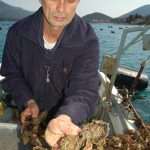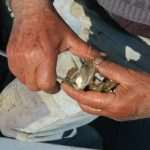If you ask any Croat what they associate with the town of Ston, oysters would be sure to get a mention, especially in the month of March.
Ston, on the peninsula of Pelješac is famous for its oysters and March 23rd is the day this year that the town celebrates its produce.
Shellfish cultivation in Mali Ston Bay presently is based on only two species: The European Flat Oyster, and the mussel. The cultivation cycle begins with collection of wild spat, sometime after which the young oysters are cemented and hung on ropes in a way used only in this area.
Oysters are fullest and most delicious in March, when St Joseph’s Day is celebrated. Gastronomy experts claim that oysters are best served freshly opened with a squeeze of lemon juice. Around the feast day of St.Joseph (19th March) every year, visitors have the opportunity to taste freshly opened oysters smelling of the sea at the restaurants in Ston and Mali Ston. The Festival of Oysters is a gastronomic event which offers oysters and oyster dishes along with the Dalmatian song and a glass of wine.
The Dalmatian coast has a long history of mariculture dating back to the Romans though the first written documents date from the time of the Dubrovnik Republic. Records from the 17th Century provide details on the collection and sale of oysters with modern development of mariculture beginning at the end of 19th Century with the establishment of oyster cultivation companies.
In 1936 at the World Exposition in London, Dubrovnik based company, “Bistrina-cultivation and sale of oysters and other shellfish” were awarded The Grand Prix and Gold Medal for oysters from Mali Ston Bay. Unfortunately, most of the private companies disappeared during the Second World War until 1946 when the first public company for the shellfish rearing was established in Bistrina Bay. At the end of 1980’s, shellfish production had reached levels of 2,000 to 3,000 tons of mussels, and 1.5 million oysters, annually.
At the beginning of the Croatian War of Independence, Bistrina and Kuti Bays found themselves on the front line and most of the farms collapsed during the hostilities. Since Croatia’s independence, cultivation has spread from the traditional grounds around Bistrina and Kuti Bays to the outer areas around Malo More. It is difficult to estimate accurately the present level of shellfish production in the area. In rough terms, it is around 1,000 tons of mussels and 500,000 oysters annually.








